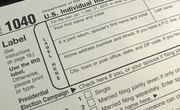
Though few people will admit to enjoying filing their taxes each year, many people appreciate getting the refund they’re entitled to and, at the very least, are glad not to have the Internal Revenue Service chasing them down for not filing. If you’ve never had a job, you might not have to file a return if you don’t have any other income. However, in some circumstances, it may be beneficial to file.
Tips
If you don't have a job and don't have any other income, you generally won't be required to file a tax return.
Not Always Exempt If You Never Had a Job
Even if you never had a job, that doesn’t mean that you don’t have any taxable income for the year. Unless income is specifically excluded, it’s taxable in the eyes of the IRS. For example, if you have interest income or have taken distributions from a traditional IRA that you inherited, that counts as taxable income. Even if you don’t have a job, you could be required to file a tax return if you have sufficient nonwage income.
Other Reasons to File
Besides having other sources of income, you could be required to file if you received advance payments of the health coverage premium tax credit. Alternatively, if you’ve never had a job where you worked as an employee, but are self-employed and never filed taxes, you could find yourself in hot water with the IRS if you don’t file a return. Self-employment income is subject to both income taxes and self-employment taxes, so the IRS requires that you file a tax return if you have $400 or more of self-employment income. Even if you don’t owe any taxes because your income is so low, if you don’t claim an exemption from withholding, filing a tax return could be beneficial for you so you can claim a refund of any income taxes withheld.
2018 Filing Thresholds
For 2018, the deduction for personal exemptions – each dependent you claim, including yourself – has been eliminated under the Tax Cuts and Jobs Act. Now, if your total income before any deductions exceeds your standard deduction, you’re required to file a tax return. However, the standard deductions have increased substantially from 2017 to 2018 to $12,000 for singles, $18,000 for heads of household and $24,000 for married couples who file jointly.
2017 Filing Thresholds
In 2017, the filing thresholds were set at the amount of your standard deduction plus a personal allowance. For example, single filers were required to file if their income exceeded $10,400 – the $6,350 standard deduction, plus a $4,050 personal allowance. For heads of household, the filing threshold increased to $13,400 because the head of household standard deduction was $9,350 in 2017. Finally, couples filing jointly weren’t required to file based on income alone until the total income exceeded $20,800.
References
- IRS: Publication 501
- Legal Information Institute: 26 USC 6012
- Tax Foundation: 2018 Tax Brackets
- IRS. "Publication 501 Dependents, Standard Deduction, and Filing Information," Pages 2-5. Accessed March 20, 2020.
- Tax Foundation. "2019 Tax Brackets." Accessed March 20, 2020.
- IRS. "Filing Status," Page 7. Accessed March 20, 2020.
Writer Bio
Based in the Kansas City area, Mike specializes in personal finance and business topics. He has been writing since 2009 and has been published by "Quicken," "TurboTax," and "The Motley Fool."

